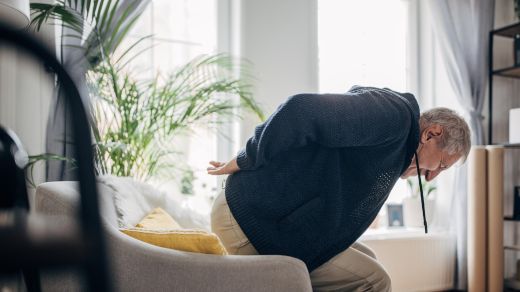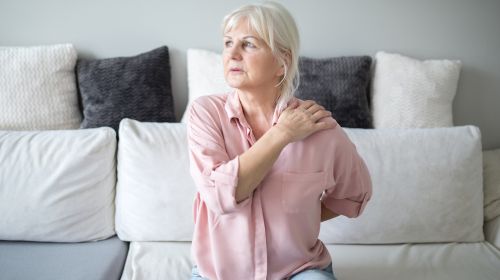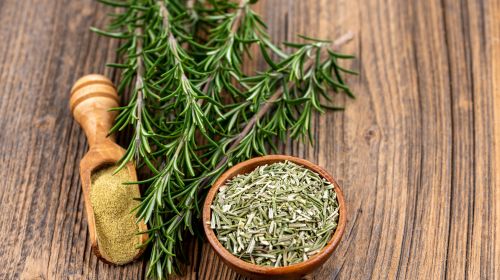Bechterew’s disease (ankylosing spondylitis) is a chronic, inflammatory, rheumatic disease that particularly affects the spine and the sacroiliac joints. In the final stage, it can lead to a stiffening of the spine and a stooped posture in those affected. Find out more about the treatment options!
- © Getty Images/South_agency
quick overview
Definition: Bechterew’s disease is a chronic inflammatory disease that primarily affects the spine.
Symptoms: Typical signs of ankylosing spondylitis are back pain and morning stiffness in the back. As the disease progresses, the mobility of the spine can be restricted.
Causes: Ankylosing spondylitis is one of the autoimmune diseases, but the exact causes have not yet been clarified.
Diagnosis: Ankylosing spondylitis can usually be diagnosed through a physical exam. If necessary, imaging methods or blood tests are used.
Treatment: The course of the disease can be positively influenced with the help of medication and physiotherapy. In rare cases, an operation is necessary.
Article content at a glance:
What exactly is ankylosing spondylitis?
Bechterew’s disease is one of the rheumatic diseases and was first described by the Russian neurologist Vladimir Bechterew (1857-1927). The disease was named after him for a long time. Today, however, experts speak of ankylosing spondylitis.
Ankylosing spondylitis is a form of axial spondyloarthritis (axSpA). These are inflammatory diseases that mainly affect the spine. The inflammation usually begins in the area of the sacroiliac joints (inflammation of the sacroiliac joints, sacroiliitis). If left untreated, there will be increasing ossification with a gradual decrease in mobility up to stiffening.
In the advanced stage, ankylosing spondylitis may manifest itself in a posture that is strongly bent forward, in which those affected can only look at the floor. However, this can be avoided with targeted physiotherapy. In addition to the spine, joints in the limbs (e.g. hip and knee joints) and internal organs can also be affected by the inflammatory changes.
Frequency of ankylosing spondylitis
Ankylosing spondylitis affects an estimated 0.1 to 1.4 percent of the adult population worldwide. The onset of the disease is usually between the ages of 15 and 35. Presumably, women and men are affected about equally often.
Morbus Bechterew: Which symptoms are typical?
As a rule, Bechterew’s disease develops very slowly and is only diagnosed at an advanced stage. Acute inflammatory phases usually alternate with more or less symptom-free periods.
An inflammatory flare-up in Bechterew’s disease often begins with back pain, which occurs mainly at night. This Deep, inflammatory back pain is the main symptom of Bechterew’s disease. The pain can radiate to the buttocks or thighs. They usually improve in the short term with exercise. Morning stiffness that lasts longer than 30 minutes is also typical.
In the late stages of ankylosing spondylitis, movement of the spine is restricted. Curvature and hump formation is also possible. If the thoracic spine is affected, this can also lead to restricted breathing.
Occasionally there is also inflammation
- other joints (such as shoulder or hip joints),
- tendon insertions,
- eyes or
- internal organs such as the heart, lungs and kidneys.
Ankylosing spondylitis: symptoms in women
For a long time it was assumed that Bechterew’s disease mainly affects men. It is now known that the disease manifests itself differently in women: Symptoms in peripheral joints (such as the wrists) usually first become noticeable in women, which makes one think of rheumatoid arthritis. The tendon attachments are also more frequently affected at the beginning. In general, women tend to remain more flexible and upright than men over a longer period of time.
Causes of ankylosing spondylitis
The exact causes of Bechterew’s disease are not known to this day. As with many rheumatic diseases, the disease is based on a malfunction of the immune system. As a result, the immune system attacks the body’s own cells and tissues, triggering the inflammatory response. Ankylosing spondylitis is therefore an autoimmune disease. In addition, experts assume that there is a hereditary predisposition.
Diagnosis of suspected ankylosing spondylitis
On average, six years elapse between the appearance of the first symptoms and a reliable diagnosis. This is because the symptoms are often uncharacteristic in the early stages and inflammation of the sacroiliac joint can only be detected in the X-ray image after a longer period of time.
Common diagnostic methods are:
physical examination: If ankylosing spondylitis is suspected, the mobility of the back and joints is usually first examined as part of a physical examination.
imaging procedures: Since the X-ray image is usually unremarkable in the early stages, despite persistent symptoms, detection can be based on magnetic resonance imaging (MRI). This procedure detects changes in the sacroiliac joints earlier than with X-rays.
blood test: The detection of HLA-B27, a genetic marker, supports the suspicion of ankylosing spondylitis, but the test is not sufficient for a reliable diagnosis.
Therapy: How is Morbus Bechterew treated?
Bechterew’s disease has not yet been cured. That is why optimal treatment is aimed at this
- to relieve pain
- to inhibit inflammation,
- maintain mobility and
- improve the quality of life of those affected.
In the treatment of Bechterew’s disease, a distinction is made between an inflammatory phase and the relapse-free period. In an acute phase, medical therapy usually includes treatment with anti-inflammatory agents and painkillers. Physiotherapy is extremely important between flare-ups to counteract the various movement restrictions.
Medication for Bechterew’s disease
As with other rheumatic diseases, non-steroidal anti-inflammatory drugs (NSAIDs) are preferably administered to relieve pain and reduce inflammation.
In addition to NSAIDs, the doctor can also prescribe so-called biological drugs in the case of a severe course of the disease, which, however, are mainly used for rheumatoid arthritis and psoriasis. They cause a causal treatment of the disease by directly targeting the immune system and blocking pro-inflammatory messenger substances.
Drugs containing cortisone (glucocorticoids) are not recommended for Bechterew’s disease, as their effectiveness in this disease has not been sufficiently proven.
physical therapy
In addition to the administration of medication, physiotherapeutic treatment that is as consistent as possible is important, ideally with water aerobics, ergotherapy, sports therapy and physical therapy (e.g. heat, cold, ultrasound). Measures such as training and psychotherapy support the success of the treatment.
Surgery for Bechterew’s disease
Surgical measures are also available for more severe forms of the disease that do not respond to this treatment concept. During the procedure, the back is straightened again and the spine is brought into its natural double S shape.
Ankylosing spondylitis: course and life expectancy
Ankylosing spondylitis is chronic and usually leads to a stiffening of the spine. The course of the disease varies greatly. There are mild courses with long, symptom-free phases without significant functional impairments. 80 percent of people with ankylosing spondylitis remain able to work for decades.
Even after a long course, the disease can come to a standstill. Only in a very small number of those affected does the spine stiffen after just ten years, despite optimal treatment. If there is no organ involvement, life expectancy in people with ankylosing spondylitis is usually unaffected.
Living with ankylosing spondylitis: exercise and nutrition are important
A healthy lifestyle has a positive effect on the course of Bechterew’s disease. This includes regular physical exercise. sports help
- to stay flexible
- reduce excess weight,
- strengthen muscles and circulation
- to improve respiratory function. Because this can be limited by the stiffening of the vertebral bodies in the chest area.
Which sports are suitable depends on how far the disease has progressed. Gentle sports that do not put a lot of strain on the joints and spine, such as swimming, cycling or hiking, are generally beneficial for rheumatic diseases.
Diet tips for Bechterew’s disease
Diet also plays an important role in many rheumatic diseases. Flare-ups and symptoms of Bechterew’s disease can be positively influenced by a suitable diet.
Animal fats in particular are considered to be pro-inflammatory. Fatty meat and sausage, lard and egg yolk should therefore only very rarely be on the menu. The consumption of cold-water fish such as herring, salmon or trout as well as dairy products, on the other hand, has a positive effect on the course of the disease. Fruit and vegetables contain vitamins and trace elements with an antioxidant effect. These can intercept oxygen radicals, which are involved in inflammatory processes in the body.



